Harman-Kardon AVR 430 User Manual
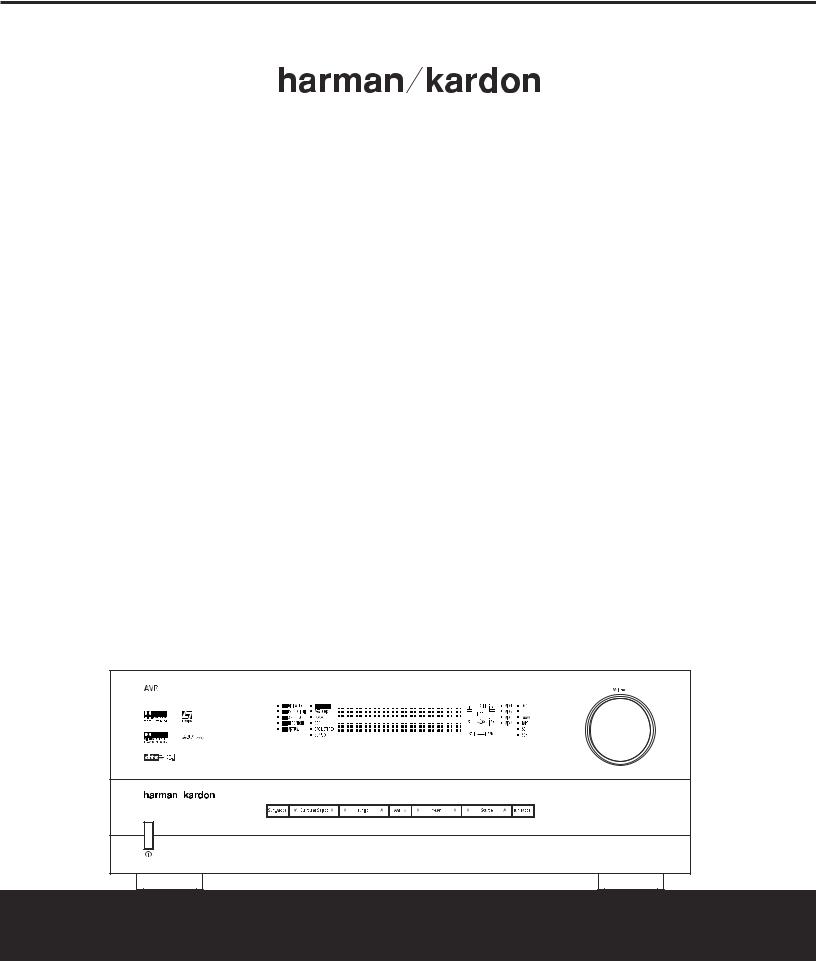
®
®
Power for the Digital Revolution.
AVR 430
AUDIO/VIDEO RECEIVER
OWNER’S MANUAL
430

AVR 430 AUDIO/VIDEO RECEIVER
3Introduction
4Safety Information
4Unpacking
5Front-Panel Controls
8 Rear-Panel Connections
11 Main Remote Control Functions
15Zone II Remote Control Functions
16Installation and Connections
19System Configuration
19Speaker Placement
19System Setup
20Input Setup
21Audio Setup
22Surround Setup
23Speaker Setup
25Delay Settings
26Output Level Adjustment
26Using EzSet
27Manual Output Level Adjustment
29Operation
29Basic Operation
29Source Selection
296-Channel/8-Channel Direct Input
29Volume and Tone Control
30Surround Mode Selection
30Digital Audio Playback
31Surround Mode Chart
33Tuner Operation
34Tape Recording
34Output Level Trim Adjustment
36Advanced Features
36Surround Amplifier Channel Assignment
36Display Brightness
36Turn-On Volume Level
37Semi-OSD Settings
37Full-OSD Time-Out Adjustment
38Multiroom Operation
38 Multiroom Setup
38 Multiroom Operation
40 Configuring the Remote
40Preprogrammed Code Entry
41Automatic Code Entry
41Learning Commands
42Changing Devices
43Macro Programming
45Punch-Through Configuration
46EzSet Configuration
47Renaming
48Resetting the Remote
50Troubleshooting Guide
50Processor Reset
51Technical Specifications
See trademark acknowledgements on page 51.
Typographical Conventions
In order to help you use this manual with the remote control, front-panel controls and rear-panel connections, certain conventions have been used.
EXAMPLE – (bold type) indicates a specific remote control or front-panel button, or rear-panel connection jack
EXAMPLE – (OCR type) indicates a message that is visible on-screen or on the front-panel information display
EXAMPLE – (Synchro type) indicates a message that is displayed on the remote control’s LCD screen
1 – (number in a square) indicates a specific front-panel control
A – (letter in a square) indicates a front-panel control that is normally concealed behind the drop-down door
¡ – (number in a circle) indicates a rear-panel connection
a – (number in an oval) indicates a button or indicator on the remote
å – (letter in an oval) indicates a button on the Zone II remote
2 TABLE OF CONTENTS

INTRODUCTION
Thank You for Choosing Harman Kardon®
With the purchase of a Harman Kardon AVR 430, you are about to begin many years of listening enjoyment.
The AVR 430 has a wide range of features and options that accommodate virtually any combination of speakers, room size and program sources. It is as easy to operate as it is to set up, but in order to take maximum advantage of the many advanced technologies within your new AVR, it is strongly recommended that you take a few minutes to read this owner’s manual.
If you have any questions about this product, its installation or its operation, we recommend that you contact your dealer or installer, as they are your best source of local information. You may also access a wealth of information and assistance by visiting our Web site
at www.harmankardon.com.
Description and Features
The AVR 430 is designed to serve as the true hub of your home entertainment system, providing a variety of listening options. When playing movies or other programming from digital formats such as DVD or HDTV the AVR decodes Dolby* Digital, Dolby Digital EX, DTS® and DTS-ES.® Two-channel stereo and matrix surround sources benefit from all current Dolby Pro Logic* II modes and DTS Neo:6.® A Harman Kardon exclusive in A/V receivers is the latest version of Logic 7® to create a wider, more enveloping sound field and more defined surround channel positioning regardless of the type of source material. Additional processing options include MP3 decoding when connected to a compatible computer.
Although the AVR 430’s primary use will be in multichannel systems, advanced technology is at work even when only two speakers are used. Dolby Virtual Speaker and Harman International’s proprietary VMAx® are both available to create enveloping sound fields from front left and right speakers, and the latest Dolby Headphone circuitry creates an amazing sense of openness with headphones. Two-channel listening with analog sources is available with full bass management or in a traditional “bypass” mode that creates a straight signal path from the gain stage to the volume control.
Along with the many listening options, the AVR 430 offers numerous settings that let you custom tailor the system. A Quadruple Crossover bass management system configures each speaker group for a different crossover setting, while the assignable wide bandwidth component video inputs may be linked to any video source. To further enhance the viewing experience with digital video sources or advanced digital video displays, the AVR 430’s A/V Sync Delay feature allows
you to compensate for the loss of lip sync common in many processing systems by delaying the audio signal independently for each input. An advanced version of Harman Kardon’s patented EzSet remote completes the package, making it easier than ever to set system output levels and to program the remote to operate virtually any program source.
The AVR 430’s multizone options and a standard Zone II remote control make it possible to listen to a separate source in one room while the main home theater uses a different source. Using the assignable rear surround channel amplifiers, you may create a basic remote listening zone without any additional equipment. The unit’s Multiroom outputs may also be used to feed an optional, external power amplifier and volume control. For one-wire multiroom connectivity, the AVR 430 is A-BUS Ready,® requiring only a single Category 5/5e cable and an optional remote module to power remote speakers while controlling volume and enabling full control over the program source and compatible IR-controlled devices.
The AVR 430’s seven-channel amplifier is our timehonored high-current, ultrawide bandwidth design with the power to reproduce the loudest crescendos or cinema sound effects while remaining virtually free from distortion or system noise.
Combining state-of-the-art circuitry, digital technology and proven performance with an elegant design that is compatible with the latest source components and video displays, the AVR 430 represents the culmination of Harman Kardon’s fifty-year history of delivering the finest sonic performance.
For Canadian model
This class B digital apparatus complies with Canadian ICES-003.
For models having a power cord with a polarized plug: CAUTION: To prevent electric shock, match wide blade of plug to wide slot, fully insert.
Modèle pour les Canadien
Cet appareil numérique de la classe B est conforme à la norme NMB-003 du Canada.
Sur les modèles dont la fiche est polarisee: ATTENTION: Pour éviter les chocs électriques, introduire la lame la plus large de la fiche dans la borne correspondante de la prise et pousser jusqu’au fond.
■All popular digital and matrix surround modes, including Dolby* Digital, Dolby Digital EX, Dolby Pro Logic* II, DTS,® DTS-ES® Discrete and Matrix, DTS Neo:6® and DTS 96/24
■Seven channels of high-current, ultrawide bandwidth amplification with the surround back channels assignable to either main room or remote room use
■Harman Kardon’s exclusive Logic 7® processing, along with a choice of either Dolby Virtual Speaker or VMAx® processing for use when only two speakers are available
■Dolby Headphone to create spacious, open sound fields when using headphones
■High-bandwidth, HDTV-compatible component video inputs may be assigned to any video input
■Full bass management for all inputs, including the analog direct inputs for DVD-Audio and SACD players, including Quadruple Crossover and individual settings for each input
■A/V Sync delay adjustable for each input delivers perfect lip sync with digital programs or video displays
■Front-panel digital audio and analog audio/video jacks may be used as either inputs or outputs for connection to portable products or video game consoles
■Extensive Multiroom options, including a standard Zone II remote, assignable rearchannel amplifier channels and A-BUS Ready® capability for listening to a separate source in a remote zone
■Easy-to-program 



 TM remote with twoline LCD display automatically sets output levels for optimal performance
TM remote with twoline LCD display automatically sets output levels for optimal performance
INTRODUCTION 3

SAFETY INFORMATION
Important Safety Information
Verify Line Voltage Before Use
Your AVR 430 has been designed for use with 120-volt AC current. Connection to a line voltage other than that for which it is intended can create a safety and fire hazard and may damage the unit.
If you have any questions about the voltage requirements for your specific model, or about the line voltage in your area, contact your selling dealer before plugging the unit into a wall outlet.
Do Not Use Extension Cords
To avoid safety hazards, use only the power cord attached to your unit. We do not recommend that extension cords be used with this product. As with all electrical devices, do not run power cords under rugs or carpets or place heavy objects on them. Damaged power cords should be replaced immediately by an authorized service center with a cord meeting factory specifications.
Handle the AC Power Cord Gently
When disconnecting the power cord from an AC outlet, always pull the plug; never pull the cord. If you do not intend to use the unit for any considerable length of time, disconnect the plug from the AC outlet.
Do Not Open the Cabinet
There are no user-serviceable components inside this product. Opening the cabinet may present a shock hazard, and any modification to the product will void your guarantee. If water or any metal object such as a paper clip, wire or a staple accidentally falls inside the unit, disconnect it from the AC power source immediately, and consult an authorized service center.
CATV or Antenna Grounding
If an outside antenna or cable system is connected to this product, be certain that it is grounded so as to provide some protection against voltage surges and static charges. Section 810 of the National Electrical Code, ANSI/NFPA No. 70-1984, provides information with respect to proper grounding of the mast and supporting structure, grounding of the lead-in wire to an antenna discharge unit, size of grounding conductors, location of antenna discharge unit, connection to grounding electrodes and requirements of the grounding electrode.
NOTE TO CATV SYSTEM INSTALLER: This reminder is provided to call the CATV (Cable TV) system installer’s attention to article 820-40 of the NEC that provides guidelines for proper grounding and, in particular, specifies that the cable ground shall be connected to the grounding system of the building, as close to the point of cable entry as possible.
Installation Location
■To ensure proper operation and to avoid the potential for safety hazards, place the unit on a firm and level surface. When placing the unit on a shelf, be certain that the shelf and any mounting hardware can support the weight of the product.
■Make certain that proper space is provided both above and below the unit for ventilation. If this product will be installed in a cabinet or other enclosed area, make certain that there is sufficient air movement within the cabinet. Under some circumstances, a fan may be required.
■Do not place the unit directly on a carpeted surface.
■Avoid installation in extremely hot or cold locations, or in an area that is exposed to direct sunlight or heating equipment.
■Avoid moist or humid locations.
■Do not obstruct the ventilation slots on the top of the unit, or place objects directly over them.
■Due to the weight of the AVR 430 and the heat generated by the amplifiers, there is the remote possibility that the rubber padding on the bottom of the unit’s feet may leave marks on certain wood or veneer materials. Use caution when placing the unit on soft woods or other materials that may be damaged by heat or heavy objects.
Cleaning
When the unit gets dirty, wipe it with a clean, soft, dry cloth. If necessary, wipe it with a soft cloth dampened with mild soapy water, then a fresh cloth with clean water. Wipe dry immediately with a dry cloth. NEVER use benzene, aerosol cleaners, thinner, alcohol or any other volatile cleaning agent. Do not use abrasive cleaners, as they may damage the finish of metal parts. Avoid spraying insecticide near the unit.
Moving the Unit
Before moving the unit, be certain to disconnect any interconnection cords with other components, and make certain that you disconnect the unit from the AC outlet.
Important Information for the User
This equipment has been tested and found to comply with the limits for a Class-B digital device, pursuant to Part 15 of the FCC Rules. The limits are designed to provide reasonable protection against harmful interference in a residential installation. This equipment generates, uses and can radiate radio-frequency energy and, if not installed and used in accordance with the instructions, may cause harmful interference to radio communication. However, there is no guarantee that harmful interference will not occur in a particular instal-
lation. If this equipment does cause harmful interference to radio or television reception, which can be determined by turning the equipment off and on, the user is encouraged to try to correct the interference by one or more of the following measures:
■Reorient or relocate the receiving antenna.
■Increase the separation between the equipment and receiver.
■Connect the equipment into an outlet on a circuit different from that to which the receiver is connected.
■Consult the dealer or an experienced radio/TV technician for help.
This device complies with Part 15 of the FCC Rules. Operation is subject to the following two conditions:
(1) this device may not cause harmful interference, and (2) this device must accept interference received, including interference that may cause undesired operation.
NOTE: Changes or modifications may cause this unit to fail to comply with Part 15 of the FCC Rules and may void the user’s authority to operate the equipment.
Unpacking
The carton and shipping materials used to protect your new receiver during shipment were specially designed to cushion it from shock and vibration. We suggest that you save the carton and packing materials for use in shipping if you move, or should the unit ever need repair.
To minimize the size of the carton in storage, you may wish to flatten it. This is done by carefully slitting the tape seams on the bottom and collapsing the carton. Other cardboard inserts may be stored in the same manner. Packing materials that cannot be collapsed should be saved along with the carton in a plastic bag.
If you do not wish to save the packaging materials, please note that the carton and other sections of the shipping protection are recyclable. Please respect the environment and discard those materials at a local recycling center.
At this time you should remove the protective plastic film from the front-panel lens. Leaving the film in place will affect the performance of your remote control.
4 SAFETY INFORMATION

FRONT-PANEL CONTROLS
^ |
% |
$ |
|
# |
|
@ |
! |
) |
430 |
|
|
|
|
|
|
|
|
A B |
C D E F G H I H |
|
J K |
L |
||||
1 |
2 |
3 |
4 |
5 |
6 |
7 |
8 |
9 |
NOTE: To make it easier to follow the instructions that refer to this illustration, a larger copy may be downloaded from the Product Support section for this product at www.harmankardon.com.
The following controls and indicators are available on the AVR 430’s front panel:
1 Standby/On Switch |
7 Input Source Selector |
# Upper Display Line |
2 Surround Mode Group Selector |
8 Tuning Mode Selector |
$ Lower Display Line |
3 Surround Mode Selector |
9 Front Panel Control Door |
% Surround Mode Indicators |
4 Tuning Selector |
) Volume Control |
^ Remote Sensor Window |
5 Tuner Band Selector |
! Input Indicators |
|
6 Preset Station Selector |
@ Speaker/Channel Input Indicators |
|
The following controls and jacks are located behind the front-panel door. To open the door, place the edge of a finger on the left or right edge of the panel and gently swing the door down towards you.
A Main Power Switch |
F Digital Input Selector |
K Coaxial 3 Digital Jack |
B Headphone Jack |
G Delay Adjust Selector |
L Video 4 Audio/Video Jacks |
C Tone Mode Button |
H ‹/› Buttons |
|
D Speaker Selector Button |
I Set Button |
|
E Channel Adjust Selector |
J Optical 3 Digital Input |
|
1 Standby/On Switch: When the Main Power Switch A is “ON,” press this button to turn on the AVR 430; press it again to turn the unit off. Note that the illumination surrounding the switch will turn blue when the unit is on.
2 Surround Mode Group Selector: Press this button to select the top-level group of surround modes. Each press of the button will select one of the surround mode categories. Once the button is pressed so
that the name of the desired surround mode category appears in the on-screen display and in the Lower Display Line $, press the Surround Mode Selector 3 to cycle through the individual modes available. For example, press this button to select Dolby modes, and then press the Surround Mode Selector
3to choose from the various mode options.
3Surround Mode Selector: Press this button to select from among the available surround mode
options for the surround mode category selected. The specific modes will vary based on the number of speakers available, the surround mode category and
whether the input source is digital or analog. For example, press the Surround Mode Group Selector 2 to select a category such as Dolby or Logic 7, and then press this button to see the specific mode choices that are available. (For more information on mode selection, see page 31.)
FRONT-PANEL CONTROLS 5

FRONT-PANEL CONTROLS
4 Tuning Selector: Press the left side of the button to tune lower-frequency stations and the right side of the button to tune higher-frequency stations. When the tuner is in the MANUAL/MONO mode, each tap of the Selector will increase or decrease the frequency by one increment. When the tuner receives a strong-enough signal for adequate reception, MANUAL TUNED will appear in the Lower Display Line $ and in the on-screen display. When the tuner is in the AUTO/STEREO mode, press the button once, and the tuner will scan for a station with acceptable signal strength. When the next
higher or lower frequency station with a strong-enough signal is tuned, the frequency scan will stop and the Lower Display Line $ and the on-screen display will indicate AUTO TUNED. When an FM Stereo station is tuned, the display will read AUTO ST TUNED. (See page 33 for more information on using the tuner.)
5 Tuner Band Selector: Pressing this button will automatically switch the AVR 430 to the Tuner mode. Pressing it again will switch between the AM and FM frequency bands. (See page 33 for more information on the tuner.)
6 Preset Station Selector: Press this button to scroll up or down through the list of stations that have been entered into the preset memory. (See page 33 for more information on tuner programming.)
7 Input Source Selector: Press this button to change the input by scrolling up or down through the list of input sources.
8 Tuning Mode Selector: Press this button to select Auto or Manual tuning. When the button is pressed so that AUTO/STEREO appears in the Upper Display Line #, the tuner will search for the next station with an acceptable signal when the Tuning Selector 4wé is pressed. When the button is pressed so that MANUAL/MONO appears in the
Upper Display Line #, each press of the Tuning Selector 4wé will increase the frequency. (See page 33 for more information on using the tuner.) This button may also be used to switch between Stereo and Mono modes for FM radio reception. When weak
reception is encountered, select the Manual/Mono tuning mode. Press and hold again to switch back to Stereo mode. (See page 33 for more information on using the tuner.)
9 Front-Panel Control Door: To open the door so that the front-panel jacks and controls behind this door may be accessed, gently pull the door down and towards you using either upper corner of the door.
) Volume Control: Turn this knob clockwise to increase the volume, counterclockwise to decrease the volume. If the AVR 430 is muted, adjusting the volume control will automatically release the unit from the silenced condition.
! Input Indicators: One of these indicators will light to identify the currently selected input. Note that the entire list will light briefly each time the unit is turned on as a test.
@ Speaker/Channel Input Indicators: These indicators are multipurpose, indicating both the speaker type selected for each channel and the incoming datasignal configuration. The left, center, right, right surround and left surround speaker indicators are composed of three boxes, while the subwoofer is a single box. The center box lights when a “small” speaker is selected, and the two outer boxes light when “large” speakers are selected. When none of the boxes are lit for the center, surround or subwoofer channels, no speaker has been assigned that position. (See page 23 for more information on configuring speakers.) The letters inside each box displays the active input channels. For standard analog inputs, only the L and R will light, indicating a stereo input. For a digital source, the indicators will light to display the channels being received at the digital input. When the letters flash, the digital input has been interrupted. (See page 32 for more information on the Channel Indicators.)
# Upper Display Line: Depending on the unit’s status, a variety of messages will appear here. In normal operation, this line will show the current input source and identify whether an analog or digital input is in use. When the tuner is selected as the input, this line will identify the station as AM or FM and show the frequency and preset number, if any.
$ Lower Display Line: Depending on the unit’s status, a variety of messages will appear here. In normal operation, the current surround mode will appear on this line.
% Surround Mode Indicators: One of these indicators will light to show the surround mode in use. Depending on the specific combination of input sources and surround mode selected, more than one indicator may light. (See page 31 for more information.)
^ Remote Sensor Window: The sensor behind this window receives infrared signals from the remote control. Aim the remote at this area and do not block or cover it unless an external remote sensor is installed.
6 FRONT-PANEL CONTROLS
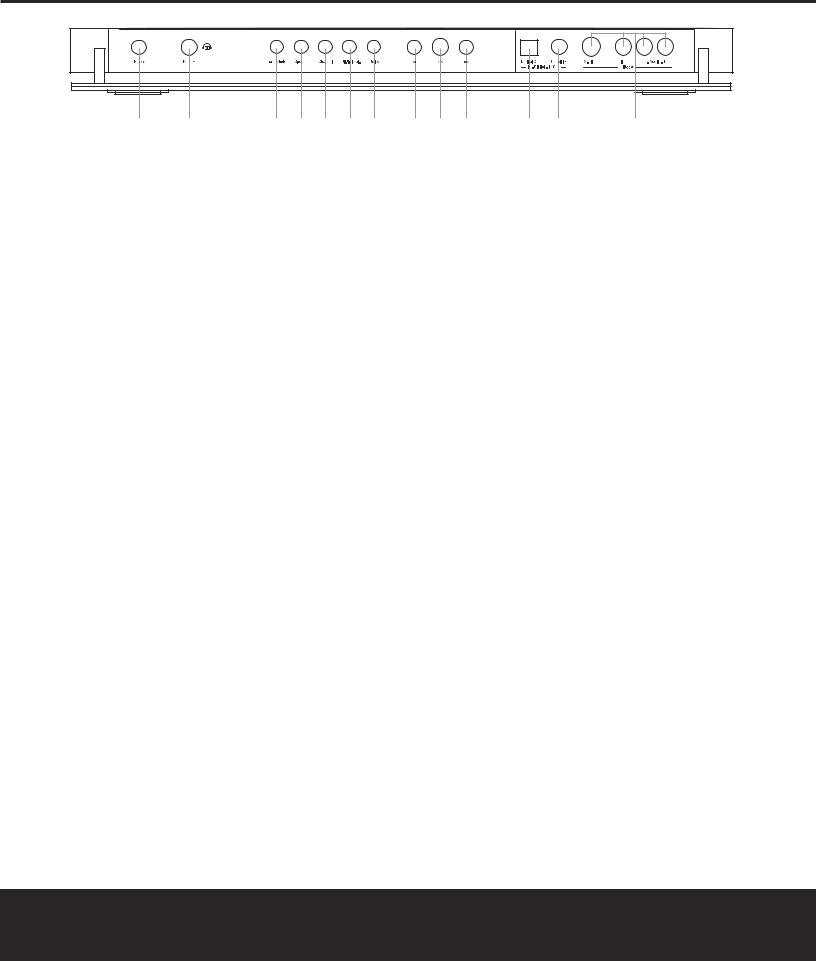
FRONT-PANEL CONTROLS
A B C D E F G H I H J K L
The following controls and jacks are located behind the front-panel door. To open the door, place the edge of a finger on the left or right edge of the panel and gently swing the door down towards you.
A Main Power Switch: Press this switch to apply power to the AVR 430. When the switch is pressed in, the unit is placed in a Standby mode, as indicated by the amber illumination surrounding the Standby/On Switch 1. This button MUST be pressed in to operate the unit. To turn the unit off and prevent the use of the remote control, this switch should be pressed until it pops out from the front panel so that the word “OFF” may be read at the top of the switch.
NOTE: This switch is normally left in the “ON” position.
B Headphone Jack: This jack may be used to listen to the AVR 430’s output through a pair of headphones. Be certain that the headphones have a standard 1/4" stereo phone plug, or that you use an adapter, as needed, to convert the plug on your headphones to the 1/4" jack used on the AVR. When the headphone jack is in use, the main room speakers will automatically be turned off and the unit will output a standard stereo signal. You may also use one of the Dolby Headphone modes for an enhanced listening experience. (For more information on headphone listening, see page 30.)
C Tone Mode Button: This button controls the tone mode settings, enabling adjustment of the bass and treble boost/cut. You may also use it to take the tone controls out of the signal path completely for “flat” response. The first press of the button displays a TONE MODE message in the Lower Display Line $ and in the on-screen display. To take the controls out of the signal path, press either of the ‹/› Buttons H until the display reads TONE OUT. To change the bass or treble settings, press the button again until the desired option appears in the Lower Display Line $ and in the on-screen display and then press either of the ‹/› Buttons H to enter the desired boost or cut setting. (See pages 21 and 29 for more information on the tone controls.)
D Speaker Selector Button: Press this button to begin the process of configuring the AVR 430 for the type of speakers it is being used with. For complete information on configuring the speaker settings, see page 23.
E Channel Adjust Selector: Press the button to begin the process of adjusting the channel level outputs using the source currently playing through your AVR. (For complete information on adjusting the channel output level, see page 34.)
F Digital Input Selector: Press this button to begin the process of selecting a digital source for use with the currently selected input. Once the button has been pressed, use the ‹/› Buttons H to choose the desired input and then press the Set Button I to enter the setting into the unit’s memory. (See page 30 for more information on digital audio.)
G Delay Adjust Selector: Press this button to begin the process of adjusting the delay settings for Dolby surround modes. (See page 25 for more information on delay adjustments.)
H ‹/› Buttons: When making system configuration changes using the front-panel controls, press these button to scroll through the available choices for the option being adjusted.
I Set Button: When making system configuration changes using the front-panel controls, press this button to enter a setting into the unit’s memory.
J Optical 3 Digital Input: Connect the optical digital output of an audio or video product to this jack.
K Coaxial 3 Digital Jack: Connect the coaxial digital input or output for a digital audio product such as a portable audio player or video game to this jack. The jack is normally an input, but may be switched to an output for recording using the menu system. (See page 34 for more information.)
L Video 4 Jacks: These audio/video jacks may be used as an input for temporary connection to video games or portable audio/video products such as camcorders and portable audio players. (See page 34 for more information.)
FRONT-PANEL CONTROLS 7
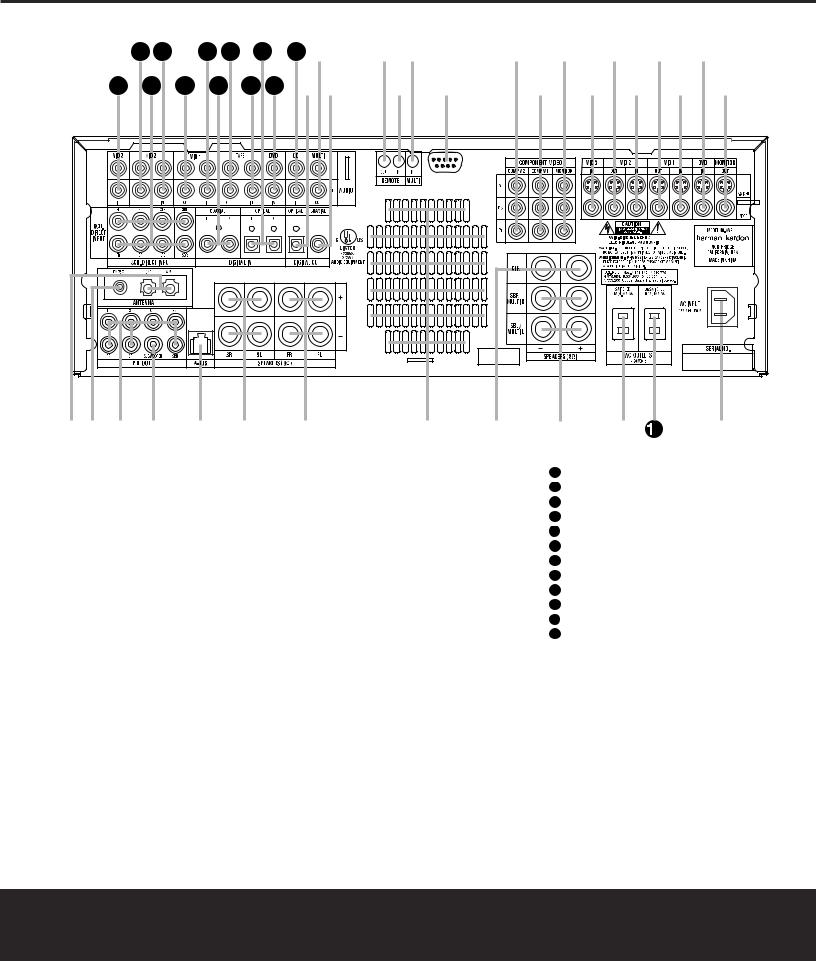
REAR-PANEL CONNECTIONS
|
41 39 |
|
37 35 |
33 |
31 j |
h f |
d |
b |
· |
‡ |
|
fi |
|
42 |
40 |
38 |
36 |
34 32 |
k i |
g |
e |
|
c |
a |
° |
fl |
› |
|
|
|
|
|
|
|
|
|
|
|
|
|
430 |
¡™ £ ¢ ∞ § ¶ |
|
• ª ‚ ⁄ 2 |
|
‹ |
|||||||||
¡ AM Antenna |
fl Video 1 Video Inputs |
31 |
™ FM Antenna |
‡ Video 1 Video Outputs |
32 |
£ Preamp Outputs |
° Video 2 Video Inputs |
33 |
¢ Subwoofer Output |
· Video 2 Video Outputs |
34 |
∞ A-BUS Connector |
a Video 3 Video Inputs |
35 |
§ Surround Speaker Outputs |
b Component Video Monitor Outputs |
36 |
¶ Front Speaker Outputs |
c Component Video 1 Inputs |
37 |
• Fan Vents |
d Component Video 2 Inputs |
38 |
ª Center Speaker Outputs |
e RS-232 Port |
39 |
‚ Surround Back/Multiroom Speaker Outputs |
f Multiroom IR Input |
40 |
⁄ Switched AC Accessory Outlet |
g Remote IR Input |
41 |
¤ Unswitched AC Accessory Outlet |
h Remote IR Output |
42 |
‹ AC Power Cord Jack |
i Coaxial Digital Audio Output |
|
› Video Monitor Outputs |
j Multiroom Audio Outputs |
|
fi DVD Video Inputs |
k Optical Digital Audio Output |
|
CD Audio Inputs
DVD Audio Inputs
Optical Digital Audio Inputs
Tape Inputs
Tape Outputs
Coaxial Digital Audio Inputs
Video 1 Audio Inputs
Video 1 Audio Outputs
Video 2 Audio Inputs
8-Channel Direct Inputs
Video 2 Audio Outputs
Video 3 Audio Inputs
NOTE: To make it easier to follow the instructions that refer to this illustration, a larger copy may be downloaded from the Product Support section for this product at www.harmankardon.com.
NOTE: To assist in making the correct connections for |
Surround Left: |
Blue |
Component Video “Y”: Green |
|
multichannel input, output and speaker connections, |
Surround Right: |
Gray |
Component Video “Pr”: Red |
|
all connection jacks and terminals are color-coded |
Surround Back Left: |
Brown |
Component Video “Pb”: Blue |
|
in conformance with the CEA standards as follows: |
Surround Back Right: |
Tan |
|
|
Front Left: |
White |
Subwoofer: |
Purple |
|
Front Right: |
Red |
Digital Audio: |
Orange |
|
Center: |
Green |
Composite Video: |
Yellow |
|
|
|
|
|
|
8 REAR-PANEL CONNECTIONS

REAR-PANEL CONNECTIONS
¡ AM Antenna: Connect the AM loop antenna supplied with the receiver to these terminals. If an external AM antenna is used, make connections to the AM and GND terminals in accordance with the instructions supplied with the antenna.
™ FM Antenna: Connect the supplied indoor or an optional external FM antenna to this terminal.
£ Preamp Outputs: Connect these jacks to an optional, external power amplifier for applications where higher power is desired.
¢ Subwoofer Output: Connect this jack to the linelevel input of a powered subwoofer. If an external subwoofer amplifier is used, connect this jack to the subwoofer amplifier input.
∞ A-BUS Connector: Connect this jack to an optional A-BUS®-certified remote room keypad or amplifier to extend the multiroom capabilities of your AVR 430.
See page 38 for more information on A-BUS.
§ Surround Speaker Outputs: Connect these outputs to the matching + and – terminals on your surround channel speakers. In conformance with the CEA color-code specification, the blue terminal is the positive, or “+” terminal that should be connected to the red (+) terminal on the Surround Left speaker with older color-coding, while the gray terminal should be connected to the red (+) terminal on the Surround Right speaker with the older color-coding. Connect the black (–) terminal on the AVR to the matching black negative (–) terminals for each surround speaker. (See page 16 for more information on speaker polarity.)
¶ Front Speaker Outputs: Connect these outputs to the matching + or – terminals on your left and right speakers. When making speaker connections always make certain to maintain correct polarity by connecting the color-coded (white for front left and red for front right) (+) terminals on the AVR 430 to the red (+) terminals on the speakers and the black (–) terminals on the AVR 430 to the black (–) terminals on the speakers. See page 16 for more information on speaker polarity.
• Fan Vents: These ventilation holes are the output of the AVR 430’s airflow system. To ensure proper operation of the unit and to avoid possible damage to delicate surfaces, make certain that these holes are not blocked and that there is at least three inches of open space between the vent holes and any wooden or fabric surface. It is normal for the fan to remain off at most normal volume levels. An automatic temperature sensor turns the fan on only when it is needed.
ª Center Speaker Outputs: Connect these outputs to the matching + and – terminals on your center channel speaker. In conformance with the CEA colorcode specification, the green terminal is the positive, or “+” terminal that should be connected to the red
(+) terminal on speakers with the older color-coding. Connect the black (–) terminal on the AVR to the black negative (–) terminal on your speaker. (See page 16 for more information on speaker polarity.)
‚ Surround Back/Multiroom Speaker Outputs:
These speaker terminals are normally used to power the surround back left/surround back right speakers in a 7.1 channel system. However, they may also be used to power the speakers in a second zone, which will receive the output selected for a multiroom system. To change the output fed to these terminals from
the default of the Surround Back speakers to the Multiroom Output, you must change a setting in the Advanced Menu of the OSD system. See page 36 for more information on configuring this speaker output. In normal surround system use, the brown and black terminals are the surround back left channel positive (+) and negative (–) connections and the tan and black terminals are the surround back right positive (+) and negative (–) terminals. For multiroom use, connect the brown and black SBL terminals to the red and black connections on the left remote zone speaker and connect the tan and black SBR terminals to the red and black terminals on the right remote zone speaker.
⁄ Switched AC Accessory Outlet: These outlets may be used to power any device you wish to have turned on when the AVR 430 is turned on with the
Standby/On Switch 1.
¤ Unswitched AC Accessory Outlet: This outlet may be used to power any AC device. The power will remain on at this outlet regardless of whether the AVR 430 is on or off.
NOTE: The total power consumption of all devices connected to the accessory outlets should not exceed 100 watts.
‹AC Power Cord Jack: Connect the AC power cord to this jack when the installation is complete. To ensure safe operation, use only the power cord supplied with the unit. If a replacement is required, it must be of the same type and capacity.
›Video Monitor Outputs: Connect these jacks to the composite or S-Video input of a TV monitor or video projector to view the on-screen menus and the output of any standard video source selected by the receiver’s video switcher.
fi DVD Video Inputs: Connect the composite or S- Video outputs of a DVD player or other video source to these jacks.
fl Video 1 Video Inputs: Connect the composite or S-Video PLAY/OUT jacks of a VCR or other video source to these jacks.
‡ Video 1 Video Outputs: Connect the composite or S-Video REC/IN jacks of a VCR or other video recording device such as a DVD recorder or PVR to these jacks.
° Video 2 Video Inputs: Connect the composite or S-Video PLAY/OUT jacks of a VCR or other video source to these jacks.
· Video 2 Video Outputs: Connect the composite or S-Video REC/IN jacks of a VCR or other video recording device such as a DVD recorder or PVR to these jacks.
a Video 3 Video Inputs: Connect the composite or S-Video PLAY/OUT jacks of a VCR or other video source to these jacks.
b Component Video Monitor Outputs: Connect these outputs to the component video inputs of a video projector or monitor. When a source connected to one of the Component Video Inputs cd is selected the signal will be sent to these jacks.
c Component Video 1 Inputs: These inputs may be used with any source device equipped with analog Y/Pr/Pb or RGB component video outputs. The factory default is for these jacks to be a linked to the DVD input, but you may change the setting at any time through the INPUT SETUP menu. (See
page 21 for more information on configuring the component video inputs.)
d Component Video 2 Inputs: These inputs may be used with any video source device equipped with analog Y/Pr/Pb or RGB component video outputs. The factory default is for these jacks to be a linked to the Video 2 input, but you may change the setting at any time through the INPUT SETUP menu. (See page 21 for more information on configuring the component video inputs.)
e RS-232 Port: This jack may be used to control the AVR 430 over a bi-directional RS-232 serial control link to a compatible computer or programmable remote control system. Due to the complexity of programming RS-232 commands we strongly recommend that connections to this port for
control purposes be made by a trained and qualified technician. This jack may also link to a compatible computer to upgrade the software and operating system of the AVR 430 when appropriate upgrades are available.
f Multiroom IR Input: Connect the output of an IR sensor in a remote room to this jack to operate the AVR 430’s multiroom control system.
REAR-PANEL CONNECTIONS 9

REAR-PANEL CONNECTIONS
g Remote IR Input: If the AVR 430’s front-panel IR sensor is blocked due to cabinet doors or other obstructions, an external IR sensor may be used.
Connect the output of the sensor to this jack.
h Remote IR Output: This connection permits the IR sensor in the receiver to serve other remote controlled devices. Connect this jack to the “IR IN” jack on Harman Kardon (or other compatible) equipment.
i Coaxial Digital Audio Output: Connect this jack to the coaxial digital input of a CD-R/RW, MiniDisc or other compatible digital recorder.
j Multiroom Audio Outputs: Connect these jacks to the optional external audio power amplifier and video distribution system that delivers the source selected for multizone distribution.
k Optical Digital Audio Output: Connect this jack to the optical digital input connector on a CD-R/RW, MiniDisc or other compatible digital recorder.
31CD Audio Inputs: Connect these jacks to the left/right analog audio output of a compact disc player or CD changer or other audio source.
32DVD Audio Inputs: Connect the left/right analog outputs of a DVD player or other audio source to these jacks.
33Optical Digital Audio Inputs: Connect the optical digital output from a DVD player, HDTV receiver, the S/P-DIF output of a compatible computer sound card playing MP3 files or streams, LD player or CD player to these jacks. The signal may be a Dolby Digital signal, a DTS signal or a standard PCM digital source.
34Tape Inputs: Connect these jacks to the Play/Oout jacks of an audio recorder.
35Tape Outputs: Connect these jacks to the Record/Input jacks of an audio recorder.
36Coaxial Digital Audio Inputs: Connect the coax digital output from a DVD player, HDTV receiver, the S/P-DIF output of a compatible computer sound card playing MP3 files or streams, LD player or CD player to these jacks. The signal may be a Dolby Digital signal, DTS signal or a standard PCM digital source. Do not connect the RF digital output of an LD player to these jacks.
37Video 1 Audio Inputs: Connect the left/right PLAY/OUT audio output jacks on a VCR or other video source to these jacks.
38Video 1 Audio Outputs: Connect the left/right REC/IN audio input jacks on a VCR or other video source to these jacks.
39Video 2 Audio Inputs: Connect the left/right PLAY/OUT audio output jacks on a VCR or other video source to these jacks.
408-Channel Direct Inputs: These jacks are used for connection to source devices such as DVD-Audio or SACD players with discrete analog outputs.
Depending on the source device in use, all eight jacks may be used, though in many cases only connections to the front left/right, center, surround left/right and LFE (subwoofer input) jacks will be used for standard 5.1 audio signals.
41Video 2 Audio Outputs: Connect the left/right REC/IN audio input jacks on a VCR or other video source to these jacks.
42Video 3 Audio Inputs: Connect the left/right PLAY/OUT audio output jacks on a VCR, PVR, cable set-top, satellite receiver, HDTV receiver or other video source to these jacks.
10 REAR-PANEL CONNECTIONS
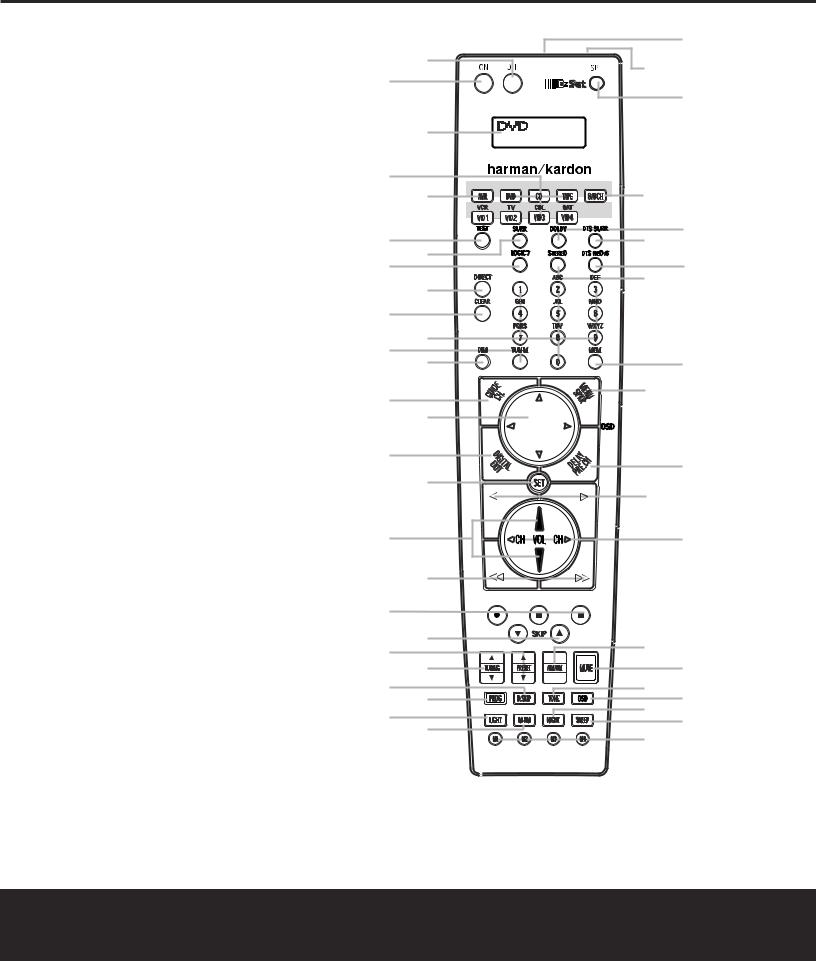
|
MAIN REMOTE CONTROL |
FUNCTIONS |
|||
0 Power Off Button |
|
|
|
|
|
1 Power On Button |
|
0 |
|
||
2 LCD Information Display |
|
|
|
||
3 Input Selectors |
1 |
|
|
||
4 AVR Selector |
|
|
|
||
|
|
|
|||
5 Test Button |
|
|
|
||
6 DSP Surround Mode Selector |
|
2 |
|
|
|
7 Logic 7 Mode Select Button |
|
|
|
||
8 Direct Button |
|
|
|
|
|
9 Clear Button |
3 |
|
|
|
|
A Numeric Keys |
|
|
|
||
B Tuning Mode Button |
|
4 |
|
|
|
m Dim Button |
|
|
|||
|
|
|
|
||
n Channel Select Button |
|
|
|
|
|
o Navigation Button |
5 |
|
|
||
|
|
||||
F Digital Select Button |
6 |
|
|||
|
|
|
|||
G Set Button |
7 |
|
|||
|
|||||
H Volume Up/Down Selectors |
8 |
||||
I Transport Fast-Play/Scan Buttons |
|
|
|
||
J Main Transport Controls |
9 |
|
|
|
|
K Track Skip Up/Down Buttons |
|
|
|
||
B A |
|
|
|||
L Preset Up/Down Button |
|
|
|||
M Tuning Up/Down Button |
|
|
|||
N Disc Skip Button |
|
C |
|
||
O Program Button |
|
|
|
|
|
P Light Button |
D |
|
|
||
|
|
|
|||
Q Multiroom Button |
|
E |
|
|
|
Macro Buttons |
|
|
|
||
|
|
|
|
||
Sleep Button |
F |
|
|
|
|
Night Mode Button |
|
|
|
||
OSD Button |
|
G |
|
||
Tone Control Button |
|
|
|
||
Mute Button |
|
|
|
|
|
AM/FM Button |
|
|
|
|
|
Channel Up/Down Selector |
H |
|
|
|
|
Transport Play Buttons |
|
|
|||
Delay Select Button |
|
|
|
|
|
Speaker Select Button |
|
I |
|
|
|
Memory Button |
|
|
|
||
|
|
|
|
||
Stereo Mode Select Button |
J |
|
|
|
|
DTS Neo:6 Mode Select Button |
|
|
|
||
DTS Digital Mode Select Button |
|
K |
|
|
|
Dolby Mode Select Button |
L |
|
|||
|
|
||||
6/8-Channel Input Select |
M |
|
|
||
|
|
||||
SPL Select Button |
N |
|
|||
EzSet Microphone Sensor |
O |
|
|||
Lens |
P |
|
|||
|
Q |
|
|||
|
|
|
|
||
|
|
|
|
||
NOTES: |
AVR 430 |
|
• The function names shown here are each button’s feature when used with the AVR 430. Most |
||
|
||
buttons have additional functions when used with other devices. When a button is pressed, the |
|
|
function name will appear in the bottom line of the LCD Information Display c. |
|
|
• The jack on the upper right side of the remote is reserved for future use. Do not remove the |
|
|
plug provided or connect any device to the jack. |
|
|
• To make it easier to follow the instructions that refer to this illustration, a larger copy may be |
|
|
downloaded from the Product Support section for this product at www.harmankardon.com. |
|
MAIN REMOTE CONTROL FUNCTIONS 11

MAIN REMOTE CONTROL FUNCTIONS
IMPORTANT NOTE: The AVR 430’s remote may be programmed to control up to eight devices, including the AVR 430. Before using the remote, it is important to remember to press the Input Selector Button 3 that corresponds to the unit you wish to operate. In addition, the AVR 430’s remote is shipped from the factory to operate the AVR 430 and most Harman Kardon CD or DVD players and cassette decks. The remote is also
capable of operating a wide variety of other products using the control codes that are part of the remote. Before using the remote with other products, follow the instructions on pages 40 – 49 to program the proper codes for the products in your system.
It is also important to remember that many of the buttons on the remote take on different functions, depending on the product selected using the Input Selectors d. The descriptions shown here primarily detail the functions of the remote when it is used to operate the AVR 430.
a Power Off Button: Press this button to place the AVR 430 or a selected device in the Standby mode. Note that this will turn off the main room functions, but if the Multiroom system is activated, it will continue to function.
1 Power On Button: Press this button to turn on the power to a device selected by first pressing one of the Input Selectors 3.
2 LCD Information Display: This two-line screen displays various information depending on the commands that have been entered into the remote.
3 Input Selectors: Pressing one of these buttons will perform three actions at the same time. First, if the AVR 430 is not turned on, this will power up the unit. Next, it will select the source shown on the button as the input to the AVR 430. Finally, it will change the remote control so that it controls the device selected. After pressing one of these buttons you must press the AVR Selector Button 4 again to operate the AVR 430’s functions with the remote.
4 AVR Selector: Pressing this button will switch the remote so that it will operate the AVR 430's functions. If the AVR 430 is in the Standby mode, it will also turn the AVR 430 on.
5 Test Button: Press this button to begin the sequence used to calibrate the AVR 430’s output levels. (See page 26 for more information on calibrating the AVR 430.)
g DSP Surround Mode Selector: Press this button to select one of the DSP surround modes, such as VMAx, Hall 1, Hall 2 or Theater. Each press of the button selects another mode. (See page 31 for more information on surround modes.)
7 Logic 7 Mode Select Button: Press this button to select from among the available Logic 7 surround modes. (See page 31 for the available Logic 7 options.)
8 Direct Button: Press this button when the tuner is in use to start the sequence for direct entry of a station’s frequency. After pressing the button, simply press the proper Numeric Keys A to select a station. (See page 33 for more information on the tuner.)
9 Clear Button: When programming the remote or using the EzSet feature, press this button to cancel the current function. When using the remote to enter frequencies for direct tuner access, press this button to clear previous entries.
A Numeric Keys: These buttons serve as a tenbutton numeric keypad to enter tuner preset positions. They are also used to select channel numbers when TV, Cable or SAT has been selected on the remote, or to select track numbers on a CD, DVD or LD player, depending on how the remote has been programmed. These buttons are also used to enter letters and numbers when renaming devices in the LCD Information Display. (See page 47 for more information on renaming devices and keys.)
B Tuning Mode Button: Press this button to change the tuner mode between manual and automatic. When the button is pressed so that AUTO/STEREO appears in the Upper Display Line # and in the on-screen display, only stations with acceptable signal quality will be tuned, and the tuner will play FM stations in stereo, when available. In the AUTO mode, when the Tuning Up/Down Buttons 4w≠ are pressed, the unit will automatically search for the next available station with good signal strength. When this button is pressed so that MANUAL/MONO appears in the Upper Display Line # and in the on-screen display each press of the Tuning Up/Down Buttons 4w≠ will move the frequency up or down in single-step increments. When the FM band is in use, pressing the button so that the MANUAL mode is activated will enable you to tune stations with weak signals by changing to monaural reception. (See page 33 for more information on tuner operation.)
m Dim Button: Press this button to activate the Dimmer function, which reduces the brightness of the front-panel display, or turns it off entirely. Press the button once to change the display to reduce the brightness by 50%, and press it again within five seconds and the main display will go completely dark. Note that this setting is temporary; regardless of any changes, the display will always return to full brightness when the AVR is turned on. The blue illumination around the Standby/On Switch 1 will always remain at full brightness regardless of the setting to remind you that the AVR is still turned on. The blue accent lighting inside the volume control will also remain at full brightness when the panel is at 50%, but go out when the panel lights are fully dimmed.
n Channel Select Button: This button is used to start the process of setting the AVR 430’s output levels to an external source. Once this button is pressed, press the ⁄/¤ on the Navigation Button o to select the channel being adjusted, then press the Set Button q, followed by the ⁄/¤ on the Navigation Button o again, to change the level setting. (See page 34 for more information.)
o Navigation Button: This single disc-like button is used to navigate through the on-screen configuration menus, to scroll through the options list and to select choices for the various settings such as delay, speakers, surround modes, digital inputs, etc. To use the button, simply press it left, right, up or down in the direction indicated by the ⁄¤‹ › icons printed on the button disc. Depending on the menu being used, pressing the button will either change a specific menu or configuration choice or it will change the option shown in the on-screen or front-panel display. The sections in this manual describing the unit’s individual features and configuration options contain specific information on how the navigation controls are used.
p Digital Select Button: Press this button to assign one of the digital inputs 33 36 JK to a source. (See page 32 for more information on using digital inputs.)
q Set Button: This button is used to enter settings into the AVR 430’s memory. It is also used in the setup procedures for delay time, speaker configuration and channel output level adjustment.
H Volume Up/Down Buttons: These controls share the common disc in the lower third of the remote. To raise the volume, press the button marked ⁄ by pressing towards the top of the remote. To lower the volume, press the button marked ¤ by pressing towards the bottom of the remote. The ‹/› buttons on the left and right sides of this disc change channels up or down when the TV, cable box or satellite Input Selectors 3 have been pressed.
12 MAIN REMOTE CONTROL FUNCTIONS

MAIN REMOTE CONTROL FUNCTIONS
s Transport Fast-Play/Scan Buttons: These buttons have no direct function on the AVR 430, but they are used when the remote is programmed for a compatible DVD, CD or tape player. Pressing these buttons will transmit a fast-play forward, fast-play reverse,
or fast-forward or -reverse scan command, according to the capabilities of the player being controlled. In the factory default setting, these buttons are preprogrammed with the remote codes for Harman Kardon DVD players so that you may control a compatible player without having to switch devices.
J Main Transport Controls: These buttons have no direct function on the AVR 430, but they are used when the remote is programmed for a compatible DVD, CD or tape player. Pressing these buttons
will transmit a stop (Í), record (Î), or pause (±) command, according to the capabilities of the player being controlled. In the factory default setting, these buttons are programmed with the remote codes for Harman Kardon DVD players so that you may control a compatible player without having to switch devices.
K Track Skip Up/Down Buttons: These buttons do not have a direct function with the AVR 430, but when used with a compatibly programmed CD or DVD changer will change the track or chapter currently being played. In the factory default setting, these buttons are programmed with the remote codes for Harman Kardon DVD players so that you may control a compatible player without having to switch devices.
L Preset Up/Down Button: When the tuner is in use, press this button to scroll through the stations programmed into the AVR 430’s memory.
w Tuning Up/Down Button: Press this button when the tuner is in use to change the station to one with a higher or lower frequency. When the tuner is in the MANUAL/MONO mode, each tap of the Selector will increase or decrease the frequency by one increment. When the tuner receives a strongenough signal for adequate reception, MANUAL TUNED will appear in the Lower Display Line $ and in the on-screen display. When the tuner is in the AUTO/STEREO mode, press the button once, and the tuner will scan for a station with acceptable signal strength. When the next higheror lowerfrequency station with a strong enough signal is tuned, the frequency scan will stop and the Lower Display Line $ and the on-screen display will indicate AUTO TUNED. When an FM Stereo station is tuned, the display will read AUTO ST TUNED. (See page 34 for more information on using the tuner.)
N Disc Skip Button: This button has no direct function for the AVR 430 but may be used to change the disc in a CD or DVD changer when the remote is programmed for that type of device.
O Program Button: This button is used to begin the process of programming the remote. Press and hold this button for three seconds to place the remote in the programming mode. Once the red LED under the Set Button q lights, release the button. You may then select from the desired option. (See pages 40 – 49 for more information on configuring the remote.)
P Light Button: Press this button to activate the remote’s backlight for ease of use in darkened rooms.
Q Multiroom Button: Press this button to begin the process of activating the multiroom system or to change the input or volume level for the second zone. (See page 38 for more information on the multiroom system.)
Macro Buttons: Press these buttons to store or recall a “Macro”, which is a preprogrammed sequence of commands stored in the remote. (See page 43 for more information on macros.)
Sleep Button: Press this button to place the unit in the Sleep mode. After the time shown in the display, the AVR 430 will automatically go into the Standby mode. Each press of the button changes the time until turn-off in the following order:
When the Sleep timer is in use the front panel displays indicators will dim to half brightness.
Night Mode Button: Press this button to activate the Night mode. This mode is available in specially encoded Dolby Digital sources, and it preserves dialogue (center channel) intelligibility at low volume levels.
OSD Button: Press this button to activate or turn off the On-Screen Display (OSD) system used to set up or adjust the AVR 430’s parameters.
Tone Control Button: This button controls the tone mode settings, enabling adjustment of the bass and treble boost/cut. You may also use it to take the tone controls out of the signal path completely for “flat” response. The first press of the button displays a
TONE IN message in the Lower Display Line $ and in the on-screen display. To take the controls out of the signal path press either of the ⁄/¤ Navigation Buttons o until the display reads TONE OUT. To change the bass or treble settings, press the button again until the desired option appears in the Lower Display Line $ and in the on-screen display and then press either of the ⁄/¤ Navigation Buttons o to enter the desired boost or cut setting. (See pages 21 and 29 for more information on the tone controls.)
Mute Button: Press this button to momentarily silence the AVR 430 or TV set being controlled, depending on which device has been selected.
AM/FM Button: Press this button to select the AVR 430’s tuner as the listening choice. Pressing this button when the tuner is already in use will select between the AM and FM bands.
Channel Up/Down Selector: This button has no function when the AVR is being controlled, but when programmed for use with a VCR, TV, cable box, satellite receiver or other similar product it will change the channel up or down. (See pages 40 – 49 for more information on programming the remote.)
Transport Play Buttons: These buttons have no direct function on the AVR 430, but they are used when the remote is programmed for a compatible DVD, CD or tape player. Pressing these buttons will transmit a forwardor reverse-play command, according to the capabilities of the player being controlled. In the factory default setting, these buttons are programmed for Harman Kardon DVD players so that you may control a compatible player without having to switch devices.
Delay Select Button: This button selects adjustments to the A/V Sync Delay and the individual channel displays. The first press of the button displays an A/V SYNC DELAY message in the Lower Display Line $ and in the on-screen display, which means that you may change the amount of time that all channels are delayed together behind the video. This enables you to compensate for the loss of lip sync that may be caused by digital video processing in your display or by television stations. To change
the A/V Sync Delay, press the Set Button q while the A/V SYNC DELAY message is visible and then use the ⁄/¤ Navigation Button o to change the setting so that the sound and the
video image are in sync. To change the delay for an individual output channel, press the ⁄/¤ Navigation Button o until the desired channel
name is shown, and then press the Set Button q. Use the ⁄/¤ Navigation Buttons o to change the delay amount. (See page 25 for more information on delay options.)
Speaker Select Button: Press this button to begin the process of configuring the AVR 430’s bass management system. Then press the ⁄/¤ Navigation Button o to select the channel you wish to set up. Press the Set Button q and then select another channel to configure. When all adjustments have been completed, press the Set Button q twice to exit the settings and return to
normal operation. (See page 23 for more information on speaker setup.)
MAIN REMOTE CONTROL FUNCTIONS 13

MAIN REMOTE CONTROL FUNCTIONS
Memory Button: Press this button to enter a radio station to the AVR 430’s preset memory. First, tune the desired station, and then press this button. Within five seconds of when you see the station’s frequency flash in the Upper Display Line # and in the on-screen display, press the numeric keys for the preset number between 01 and 30 that you
wish to assign to the station. (See page 33 for more information.)
Stereo Mode Select Button: Press this button to select a stereo listening mode. When the button is pressed so that SURROUND OFF appears in the Lower Display Line $, the AVR will operate in either a bypass mode with true, fully analog, twochannel left/right stereo mode with no surround processing or with full bass management, as opposed to other modes where digital processing is always used. When the button is pressed so that SURROUND OFF appears in the Lower Display Line $, and the DSP and SURROUND OFF Surround Mode Indicators % are lit, you will enjoy a twochannel presentation of the sound along with the benefits of bass management. Depending on whether your system is configured for 5.1 or 6.1/7.1 channels, the next press of the button will cause either
5 CH STEREO or 7 CH STEREO to appear, and the stereo signal will be routed to all five (or seven) speakers. (See page 31 for more information on stereo playback modes.)
DTS Neo:6 Mode Select Button: Press this button to select a DTS Neo:6 mode. (See page 31 for the available DTS Neo:6 options.)
DTS Digital Mode Select Button: When a DTS-encoded digital source is playing, each press of this button will scroll through the available DTS modes. The specific choice of modes will vary according to the type of encoding on the disc and your system’s speaker configuration. When a DTS source is not in use, this button has no function. (See page 31 for the available DTS digital options.)
Dolby Mode Select Button: This button is used to select from the available Dolby Surround modes. Each press of this button will select one of the Dolby Pro Logic II modes or Dolby 3 Stereo. When a Dolby Digital-encoded source is in use, the Dolby Digital mode may also be selected. (See page 31 for the available Dolby surround mode options.)
6-Channel/8-Channel Input Select: Press this button to select the device connected to the 6- or 8- Channel Direct Inputs 40 . (See page 29 for more information.)
SPL Select Button: This button activates the EzSet function to quickly and accurately calibrate the AVR 430’s output levels. When the button is pressed you will then need to select between automatic EzSet operation or using the remote as a manual SPL meter by pressing the ⁄/¤ Navigation Button o until your choice appears in the remote’s LCD display. Press the Set Button q to enter the setting, and then follow the instructions as displayed in the LCD display. (For complete information, see page 26.)
EzSet Microphone Sensor: The microphone sensor that is used by the EzSet system is behind the three slots at the top of the remote control. When using EzSet to calibrate the AVR 430, be certain that the slots are not covered. (See page 26 for more information on using EzSet.)
Lens: The infrared emitters behind the plastic lens at the top of the remote communicate the remote codes to the AVR 430. Be certain that the lens is not covered when using the remote, and point the lens toward the AVR for best results. In learning mode, the remote receives IR codes to be learned through a sensor behind the lens.
NOTE: DO NOT remove the rubber plug that is supplied to cover the jack on the upper right side of the remote. The jack is not active and is reserved for future use.
14 MAIN REMOTE CONTROL FUNCTIONS
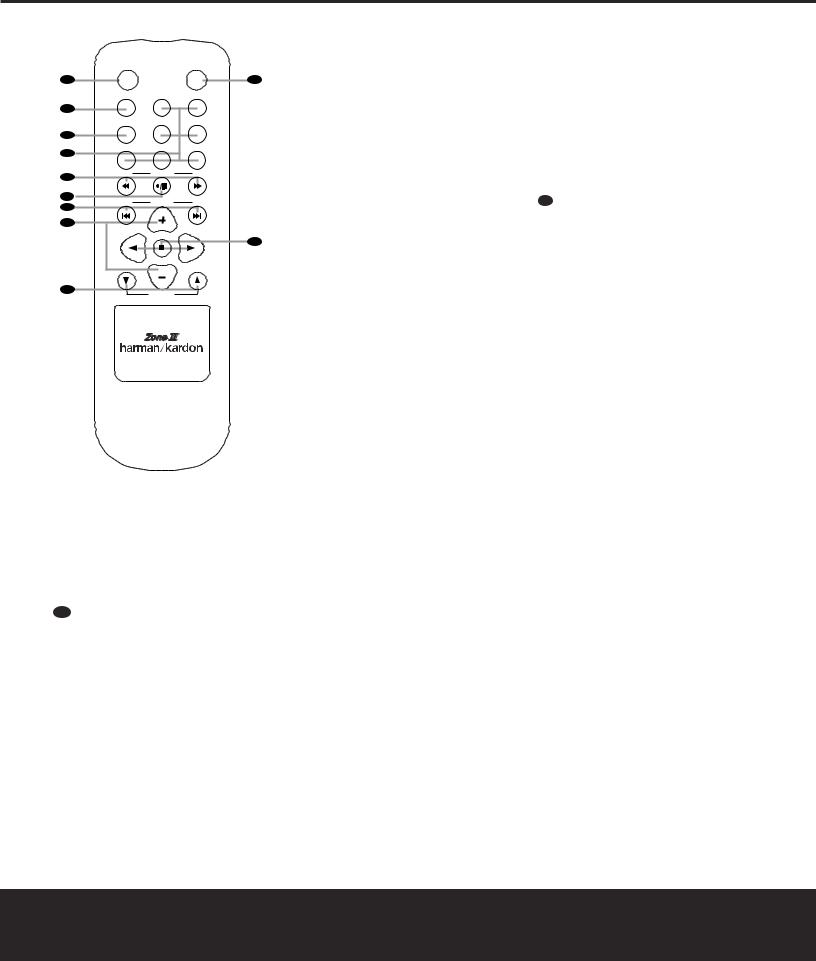
ZONE II REMOTE CONTROL FUNCTIONS
|
POWER |
|
MUTE |
|
A |
OFF |
|
K |
|
|
AVR |
VID1 |
VID2 |
|
B |
|
|
|
|
|
AM/FM |
VID3 |
VID4 |
|
C |
|
|
|
|
D |
DVD |
CD |
TAPE |
|
|
|
|
||
E |
DN |
TUNING |
UP |
|
|
|
|
||
F |
DN |
PRESET |
UP |
|
G |
||||
|
|
|
H
DISC SKIP
J
DISC SKIP
I
VOLUME
å Power Off Button
∫ AVR Selector Button
ç AM/FM Tuner Selector
∂ Input Selectors
≠ Tuning Up/Down – Fast Play Buttons
ƒ Record/Pause Button
© Preset Up/Down – Track Skip Buttons
˙ Disc Skip Button
I Volume Up/Down Buttons
∆ Play Forward/Reverse/Stop Buttons
˚ Mute Button
å Power Off Button: When used in the room where the AVR 430 is located, press this button to place the unit in Standby. When it is used in a remote room with a sensor that is connected to the Multiroom IR Input f jack, this button turns the Multiroom system on and off.
∫ AVR Selector Button: Press this button to turn on the AVR 430. The input in use when the unit was last on will be selected.
ç AM/FM Tuner Selector: Press this button to select the Tuner as the input to the Multiroom system. Press it again to change between the AM and FM bands.
∂ Input Selectors: When the AVR 430 is off, press one of these buttons to select a specific input and turn the unit on. When the unit is already in use, pressing one of these buttons will change the input.
≠ Tuning Up/Down – Fast Play Buttons: When the Zone II remote is used in the same room as the AVR 430, these buttons may be used to change the frequency of the tuner. These buttons may also control the Fast Play or Fast Reverse functions of compatible Harman Kardon CD, DVD or cassette decks in the same room, or from a remote room when an IR link is connected to the AVR 430.
ƒ Record/Pause Button: Press this button to activate the Record or Pause function on compatible Harman Kardon CD, DVD or cassette deck products.
© Preset Up/Down – Track Skip Buttons: When the AVR 430’s tuner is selected as the input source, these buttons will move up or down through the list of stations that have been stored in the preset memory. When a CD or DVD changer or player is selected, these buttons activate the Forward or Reverse Track or Chapter Skip functions.
˙ Disc Skip Buttons: Press these buttons to change discs on compatible Harman Kardon CD or DVD changer or players.
I Volume Up/Down Buttons: When the Zone II remote is used in the room where the AVR 430 is located, press this button to raise or lower the volume in that room. When it is used in a remote room with a sensor that is connected to the Multiroom IR Input f jack, this button will raise or lower the volume in the remote room.
∆ Play Forward/Reverse/Stop Buttons: Press these buttons to control compatible Harman Kardon CD, DVD or cassette players.
˚ Mute Button: When the Zone II remote is used in the room where the AVR 430 is located, press this button to temporarily silence the unit. When it is used in a remote room with a sensor that is connected
to the Multiroom IR Input f jack, this button will temporarily silence the feed to the remote room only. Press the button again to return to the previous volume level.
NOTES:
•The Zone II remote may be used in either the same room where the AVR 430 is located, or it may be used in a separate room with an optional infrared sensor that is connected to the AVR 430’s Multiroom IR Input f jack. When it is used in the same room as the AVR 430, it will control the functions of the AVR 430 or any compatible Harman Kardon products in that room. When it is used in a separate room via a sensor connected to the Multiroom IR Input f jack, the buttons for Power, Input Source, Volume and Mute will control the source
and volume for the second zone, as connected to the Multiroom Audio Outputs j jacks. (See page 38 for complete information on using the Multiroom system.)
•To make it easier to follow the instructions that refer to the controls and connectors in this illustration, a larger copy may be downloaded from the Product Support section for this product at www.harmankardon.com.
ZONE II REMOTE CONTROL FUNCTIONS 15
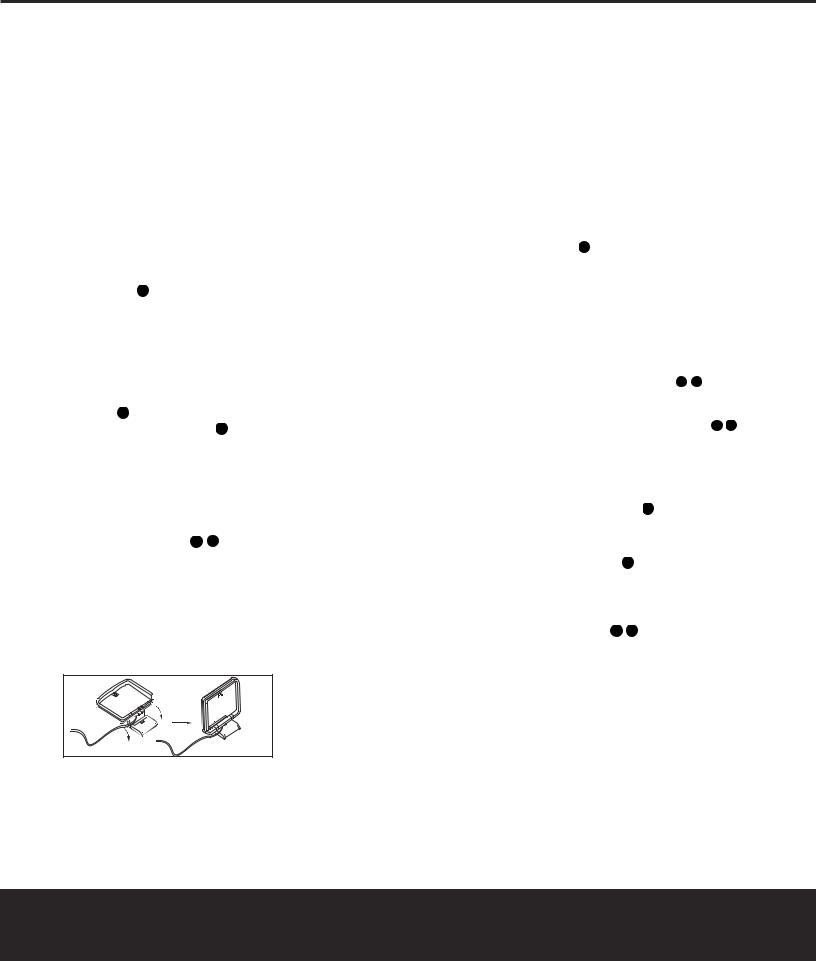
INSTALLATION AND CONNECTIONS
System Installation
After unpacking the unit, locating it in a place with adequate ventilation and placing it on a solid surface capable of supporting its weight, you will need to make the connections to your audio and video equipment.
IMPORTANT NOTE: For your personal safety and to avoid possible damage to your equipment and speakers, it is always good practice to turn off and unplug the AVR and ALL source equipment from the AC output before making any audio or video system connections.
Audio Equipment Connections
We recommend that you use high-quality interconnect cables when making connections to source equipment and recorders to preserve the integrity of the signals.
1. Connect the analog output of a CD player to the
CD Audio Inputs 31.
NOTE: If your CD player has both fixed and variable audio outputs, it is best to use the fixed output unless you find that the input to the receiver is so low that the sound is noisy, or so high that it is distorted.
2.Connect the analog Play/Out jacks of a cassette deck, MD, CD-R or other audio recorder to the
Tape Inputs 34. Connect the analog Record/In jacks on the recorder to the Tape Outputs 35 on the AVR 430.
3.Connect the output of any digital sources such as such as a CD or DVD changer or player, advanced video game, a digital satellite receiver, HDTV tuner or digital cable set-top box or the output of a compatible computer sound card to the Optical and
Coaxial Digital Audio Inputs 33 36 JK.
4.Connect the coaxial or optical Digital Audio Outputs ik on the rear panel of the AVR 430 to the matching digital input connections on a CD-R or MiniDisc recorder.
5.Assemble the AM loop antenna supplied with the unit so that the tabs at the bottom of the antenna loop snap into the holes in the base. Connect it to the AM and
GND Screw Terminals ¡.
6. Connect the supplied FM antenna to the FM (75Ohm) Connection ™. The FM antenna may be an external roof antenna, an inside powered or wire-lead antenna or a connection from a cable TV system. If the antenna or connection uses 300-ohm twin-lead cable, you must use an optional 300-ohm-to-75-ohm adapter to make the connection.
7. Connect the front, center, surround and surround back speaker outputs §¶ª‚ to the respective speakers.
To ensure that all the audio signals are carried to your speakers without loss of clarity or resolution, we suggest that you use high-quality speaker cable. Many brands of cable are available and the choice of cable may be influenced by the distance between your speakers and the receiver, the type of speakers you use, personal preferences and other factors. Your dealer or installer is a valuable resource to consult in selecting the proper cable.
Regardless of the brand of cable selected, we recommend that you use cable with a gauge of 14 or smaller. Remember that in specifying cable, the lower the number, the thicker the cable.
Cable with a gauge of 16 may be used for short runs of less than ten feet. We do not recommend that you use cables with an AWG equivalent of 18 or higher, due to the power loss and degradation in performance that will occur.
Cables that are run inside walls should have the appropriate markings to indicate listing with UL, CSA or other appropriate testing agency standards. Questions about running cables inside walls should be referred to your installer or a licensed electrician who is familiar with the NEC and/or the applicable building codes in
your area.
When connecting wires to the speakers, be certain to observe proper polarity. Note that the positive (+) terminal of each speaker connection now carries a specific color code, as noted on page 8. However, most speakers still use a red terminal for the positive
(+) connection. Connect the “negative” or “black” wire to the same terminal on both the receiver and the speaker.
NOTE: While most speaker manufacturers adhere to an industry convention of using black terminals for negative and red ones for positive, some may vary from this configuration. To ensure proper phase and optimal performance, consult the identification plate on your speaker or the speaker’s manual to verify polarity. If you do not know the polarity of your speaker, ask your dealer for advice before proceeding, or consult the speaker’s manufacturer.
We also recommend that the length of cable used to connect speaker pairs be identical. For example, use the same length piece of cable to connect the front-left and front-right or surround-left and sur- round-right speakers, even if the speakers are a different distance from the AVR 430.
8.Connections to a subwoofer are normally made via a line-level audio connection from the Subwoofer Output ¢ to the line-level input of a subwoofer with a built-in amplifier. When a passive subwoofer is used, the connection first goes to a power amplifier, which will be connected to one or more subwoofer speakers. If you are using a powered subwoofer that does not have line-level input connections, follow the instructions furnished with the speaker for connection information.
9.If an external multichannel audio source with 5.1 outputs such as an external digital processor/decoder, DVD-Audio or SACD player is used, connect the outputs of that device to the 8-Channel Direct Inputs 40 .
Video Equipment Connections
Video equipment is connected in the same manner as audio components. Again, the use of high-quality interconnect cables is recommended to preserve signal quality.
1.Connect a VCR’s or other video source’s audio and video Play/Out jacks to the Video 1/Video 2 Audio and Video Input Jacks fl°37 39 on the rear panel. The Audio and Video Record/In jacks on the VCR should be connected to the Video 1/Video 2 Audio and Video Output Jacks ‡·38 41 on the AVR 430.
2.Connect the analog audio and video outputs of a satellite receiver, cable TV converter or television set or any other video source to the VIdeo 3 Audio and Video Input Jacks a42 .
3.Connect the analog audio and video outputs of a DVD or laser disc player to the DVD Audio and Video Inputs fi32 .
4.Connect the optical or coaxial digital audio outputs of a DVD player, satellite receiver, cable box, HDTV tuner or video game to any of the Optical or Coaxial Digital Inputs 33 36 JK. The recommended connection for a DVD player is to use a Coaxial digital link connected to the Coaxial Digital Audio Input 1, but you may change the digital audio input assignment for any source using the INPUT SETUP menu as
described on page 21 or the Digital Input Selector Fp on the front panel or remote, as described on page 32.
NOTE: When connecting a device such as a digital cable box or other set-top tuner product with a digital audio output, we recommend that you connect both the digital and analog outputs of the product to your AVR. The audio input polling feature of the AVR will then be able to make certain that you have a constant audio feed, since it will automatically switch the audio input to the analog jacks if the digital feed is interrupted or not available for a particular channel.
16 INSTALLATION AND CONNECTIONS
